OCT
-
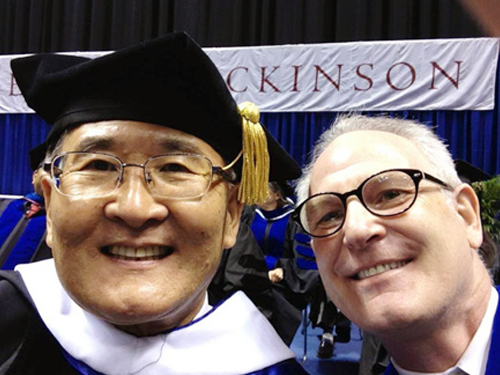 President Steve Kang Received an Honorary Degree from Fairleigh Dickinson University
At its 71st Commencement held on May 20, 2014, Fairleigh Dickinson University (FDU) in Teaneck, NJ, conferred an honorary doctorate (Doctor of Science) on President Steve Kang. FDU is President Kang’s alma mater. He received a bachelor’s degree from FDU in electrical engineering in 1970.
For details, please refer to the press statement released by FDU on May 20, 2014.
Fairleigh Dickinson University holds 71st Commencement on May 20
During the Commencement ceremony, the University will confer honorary degrees on Joyce Carol Oates, Rachel Robinson, and Sung Mo “Steve” Kang (BSEE’70).
http://inside.fdu.edu/prpt/71st_commencement.html
2014.05.25 View 8576
President Steve Kang Received an Honorary Degree from Fairleigh Dickinson University
At its 71st Commencement held on May 20, 2014, Fairleigh Dickinson University (FDU) in Teaneck, NJ, conferred an honorary doctorate (Doctor of Science) on President Steve Kang. FDU is President Kang’s alma mater. He received a bachelor’s degree from FDU in electrical engineering in 1970.
For details, please refer to the press statement released by FDU on May 20, 2014.
Fairleigh Dickinson University holds 71st Commencement on May 20
During the Commencement ceremony, the University will confer honorary degrees on Joyce Carol Oates, Rachel Robinson, and Sung Mo “Steve” Kang (BSEE’70).
http://inside.fdu.edu/prpt/71st_commencement.html
2014.05.25 View 8576 -
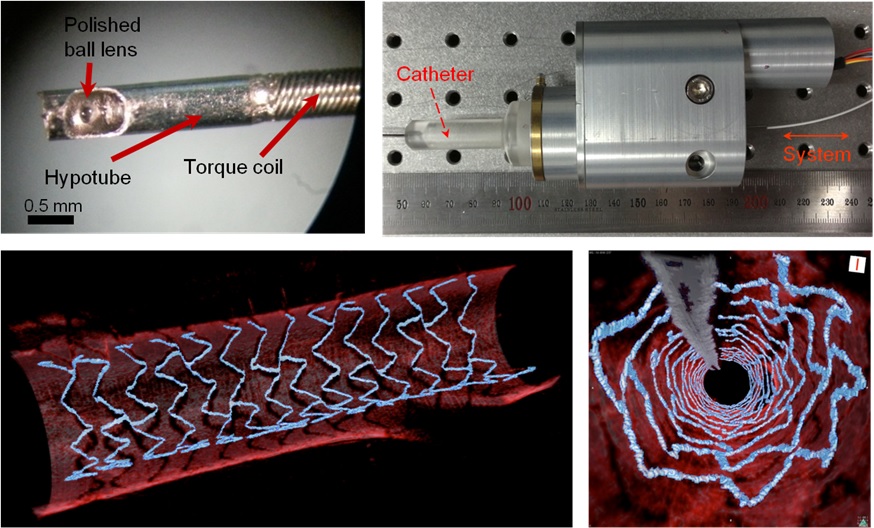 High Resolution 3D Blood Vessel Endoscope System Developed
Professor Wangyeol Oh of KAIST’s Mechanical Engineering Department has succeeded in developing an optical imaging endoscope system that employs an imaging velocity, which is up to 3.5 times faster than the previous systems. Furthermore, he has utilized this endoscope to acquire the world’s first high-resolution 3D images of the insides of in vivo blood vessel.
Professor Oh’s work is Korea’s first development of blood vessel endoscope system, possessing an imaging speed, resolution, imaging quality, and image-capture area. The system can also simultaneously perform a functional imaging, such as polarized imaging, which is advantageous for identifying the vulnerability of the blood vessel walls.
The Endoscopic Optical Coherence Tomography (OCT) System provides the highest resolution that is used to diagnose cardiovascular diseases, represented mainly by myocardial infarction.
However, the previous system was not fast enough to take images inside of the vessels, and therefore it was often impossible to accurately identify and analyze the vessel condition. To achieve an in vivo blood vessel optical imaging in clinical trials, the endoscope needed to be inserted, after which a clear liquid flows instantly, and pictures can be taken in only a few seconds.
The KAIST research team proposed a solution for such problem by developing a high-speed, high-resolution optical tomographic imaging system, a flexible endoscope with a diameter of 0.8 mm, as well as a device that can scan the imaging light within the blood vessels at high speed. Then, these devices were combined to visualize the internal structure of the vessel wall.
Using the developed system, the researchers were able to obtain high-resolution images of about 7 cm blood vessels of a rabbit’s aorta, which is similar size to human’s coronary arteries. The tomography scan took only 5.8 seconds, at a speed of 350 scans per second in all three directions with a resolution of 10~35㎛.
If the images are taken every 200 ㎛, like the currently available commercial vascular imaging endoscopes, a 7cm length vessel can be imaged in only one second.
Professor Wangyeol Oh said, “Our newly developed blood vessel endoscope system was tested by imaging a live animal’s blood vessels, which is similar to human blood vessels. The result was very successful.”
“Collaborating closely with hospitals, we are preparing to produce the imaging of an animal’s coronary arteries, which is similar in size to the human heart,” commented Professor Oh on the future clinical application and commercialization of the endoscope system. He added, “After such procedures, the technique can be applied in clinical patients within a few years.”
Professor Oh’s research was supported by the National Research Foundation of Korea and the Global Frontier Project by the Korean government. The research results were published in the 2014 January’s edition of Biomedical Optics Express.
Figure 1: End portion of optical endoscope (upper left)
Figure 2: High-speed optical scanning unit of the endoscope (top right)
Figure 3: High-resolution images of the inside of in vivo animal blood vessels (in the direction of vascular circumference and length)
Figure 4: High-resolution images of the inside of in vivo animal blood vessels (in the direction of the vein depth)
2014.03.25 View 13047
High Resolution 3D Blood Vessel Endoscope System Developed
Professor Wangyeol Oh of KAIST’s Mechanical Engineering Department has succeeded in developing an optical imaging endoscope system that employs an imaging velocity, which is up to 3.5 times faster than the previous systems. Furthermore, he has utilized this endoscope to acquire the world’s first high-resolution 3D images of the insides of in vivo blood vessel.
Professor Oh’s work is Korea’s first development of blood vessel endoscope system, possessing an imaging speed, resolution, imaging quality, and image-capture area. The system can also simultaneously perform a functional imaging, such as polarized imaging, which is advantageous for identifying the vulnerability of the blood vessel walls.
The Endoscopic Optical Coherence Tomography (OCT) System provides the highest resolution that is used to diagnose cardiovascular diseases, represented mainly by myocardial infarction.
However, the previous system was not fast enough to take images inside of the vessels, and therefore it was often impossible to accurately identify and analyze the vessel condition. To achieve an in vivo blood vessel optical imaging in clinical trials, the endoscope needed to be inserted, after which a clear liquid flows instantly, and pictures can be taken in only a few seconds.
The KAIST research team proposed a solution for such problem by developing a high-speed, high-resolution optical tomographic imaging system, a flexible endoscope with a diameter of 0.8 mm, as well as a device that can scan the imaging light within the blood vessels at high speed. Then, these devices were combined to visualize the internal structure of the vessel wall.
Using the developed system, the researchers were able to obtain high-resolution images of about 7 cm blood vessels of a rabbit’s aorta, which is similar size to human’s coronary arteries. The tomography scan took only 5.8 seconds, at a speed of 350 scans per second in all three directions with a resolution of 10~35㎛.
If the images are taken every 200 ㎛, like the currently available commercial vascular imaging endoscopes, a 7cm length vessel can be imaged in only one second.
Professor Wangyeol Oh said, “Our newly developed blood vessel endoscope system was tested by imaging a live animal’s blood vessels, which is similar to human blood vessels. The result was very successful.”
“Collaborating closely with hospitals, we are preparing to produce the imaging of an animal’s coronary arteries, which is similar in size to the human heart,” commented Professor Oh on the future clinical application and commercialization of the endoscope system. He added, “After such procedures, the technique can be applied in clinical patients within a few years.”
Professor Oh’s research was supported by the National Research Foundation of Korea and the Global Frontier Project by the Korean government. The research results were published in the 2014 January’s edition of Biomedical Optics Express.
Figure 1: End portion of optical endoscope (upper left)
Figure 2: High-speed optical scanning unit of the endoscope (top right)
Figure 3: High-resolution images of the inside of in vivo animal blood vessels (in the direction of vascular circumference and length)
Figure 4: High-resolution images of the inside of in vivo animal blood vessels (in the direction of the vein depth)
2014.03.25 View 13047 -
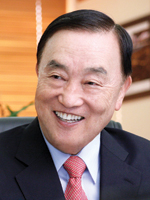 Former Minister of Science and Technology, Dr. KunMo Chung, Awarded KAIST Honorary Doctorate
KAIST will confer an honorary doctorate on former minister of Science and Technology, Dr. KunMo Chung, at the 2014 KAIST graduation ceremony on Friday, February, 21.Dr. Chung presented the Survey Report for the Establishment of the Korea Advanced Institute of Science (KAIS) to the United States Agency for International Development (USAID) in 1969. This proposal for nurturing the advanced science technology elite and boost Korean industrial development became the foundation for KAIS, which is now known as KAIST.After passing the KAIS Foundation Law in 1970, Dr. Chung designed the faculty room, secured faculty members, and acquired a $6 million education loan from the USAID. Dr. Chung devoted himself to research and teaching. His first appointment was the position of assistant professor at the University of South Florida, followed by research professor positions at the Princeton Nuclear Fusion Research Center and MIT Nuclear Engineering, and an associate professor position in the Department of Electrophysics at the Polytechnic Institute of New York.When KAIS was founded on Feb. 16, 1971, 31-year-old Dr. KunMo Chung became the provost and a professor in the Electronic and Electrical Science Department where he made outstanding contributions to the development of science and technology in Korea.
2014.02.21 View 11656
Former Minister of Science and Technology, Dr. KunMo Chung, Awarded KAIST Honorary Doctorate
KAIST will confer an honorary doctorate on former minister of Science and Technology, Dr. KunMo Chung, at the 2014 KAIST graduation ceremony on Friday, February, 21.Dr. Chung presented the Survey Report for the Establishment of the Korea Advanced Institute of Science (KAIS) to the United States Agency for International Development (USAID) in 1969. This proposal for nurturing the advanced science technology elite and boost Korean industrial development became the foundation for KAIS, which is now known as KAIST.After passing the KAIS Foundation Law in 1970, Dr. Chung designed the faculty room, secured faculty members, and acquired a $6 million education loan from the USAID. Dr. Chung devoted himself to research and teaching. His first appointment was the position of assistant professor at the University of South Florida, followed by research professor positions at the Princeton Nuclear Fusion Research Center and MIT Nuclear Engineering, and an associate professor position in the Department of Electrophysics at the Polytechnic Institute of New York.When KAIS was founded on Feb. 16, 1971, 31-year-old Dr. KunMo Chung became the provost and a professor in the Electronic and Electrical Science Department where he made outstanding contributions to the development of science and technology in Korea.
2014.02.21 View 11656 -
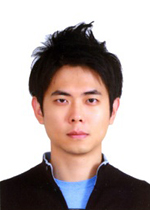 Hyun-Sik Kim, KAIST doctoral student, receives Predoctoral Achievement Award from IEEE Solid-State Circuits Society
Hyun-Sik Kim, a Ph.D. student from the Department of Electrical Engineering, is scheduled to receive the “Predoctoral Achievement Award” from the Institute of Electrical and Electronics Engineers (IEEE) Solid-State Circuit Society (SSCS) at its 2014 annual conference to be held on February 9-13 in San Francisco, USA. Kim, the first Korean student receiving the award, will also be given a 1,000 USD honorarium.
Established in 1983, the Predoctoral Achievement Award has been given to a small number of promising graduate students, which is made on the basis of academic record and potential, quality of publications, and a graduate study program well matched to the charter of SSCS. Among the previous recipients were Professor Bernhard Boser of the University of California in Berkeley and Professor Michael Flynn of Michigan University.
Kim published 15 research papers in international journals and conferences, applied for 35 domestic and international patents, and received the best paper award in human technology from Samsun Electronics for three consecutive years.
Professor Kyu-Hyung Cho of Electrical Engineering is Kim's principal advisor.
2014.01.27 View 12376
Hyun-Sik Kim, KAIST doctoral student, receives Predoctoral Achievement Award from IEEE Solid-State Circuits Society
Hyun-Sik Kim, a Ph.D. student from the Department of Electrical Engineering, is scheduled to receive the “Predoctoral Achievement Award” from the Institute of Electrical and Electronics Engineers (IEEE) Solid-State Circuit Society (SSCS) at its 2014 annual conference to be held on February 9-13 in San Francisco, USA. Kim, the first Korean student receiving the award, will also be given a 1,000 USD honorarium.
Established in 1983, the Predoctoral Achievement Award has been given to a small number of promising graduate students, which is made on the basis of academic record and potential, quality of publications, and a graduate study program well matched to the charter of SSCS. Among the previous recipients were Professor Bernhard Boser of the University of California in Berkeley and Professor Michael Flynn of Michigan University.
Kim published 15 research papers in international journals and conferences, applied for 35 domestic and international patents, and received the best paper award in human technology from Samsun Electronics for three consecutive years.
Professor Kyu-Hyung Cho of Electrical Engineering is Kim's principal advisor.
2014.01.27 View 12376 -
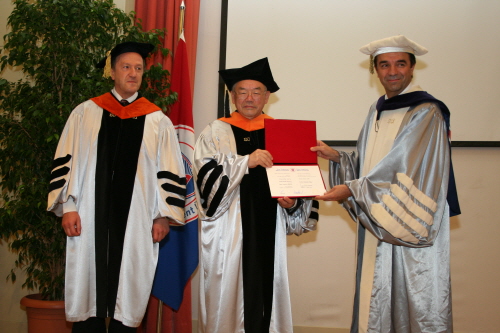 President Nam Pyo Suh receives Honorary Doctorate from Bilkent University, Turkey
President of KAIST Nam Pyo Suh received an Honorary Doctorate from Turkey’s Bilkent University on June 13th, 2012.
Bilkent University revealed that it is President Suh’s invention of a plastic manufacture process used all over the world and the combination of academic achievements like the creation of the axiomatic design theory that merits the Honorary Doctorate.
After the presentation ceremony, President Suh gave a lecture to professors and students at Bilkent University on the "University of the Future: Changing Education Paradigm."
Bilkent University is located in Ankara, the capital of Turkey and was established in 1984, which is largely regarded as Turkey’s best private university. It ranked 32 out of 50 universities in Times Higher Educations’ 100 Under 50 List of World’s Best New Universities.
2012.06.18 View 9927
President Nam Pyo Suh receives Honorary Doctorate from Bilkent University, Turkey
President of KAIST Nam Pyo Suh received an Honorary Doctorate from Turkey’s Bilkent University on June 13th, 2012.
Bilkent University revealed that it is President Suh’s invention of a plastic manufacture process used all over the world and the combination of academic achievements like the creation of the axiomatic design theory that merits the Honorary Doctorate.
After the presentation ceremony, President Suh gave a lecture to professors and students at Bilkent University on the "University of the Future: Changing Education Paradigm."
Bilkent University is located in Ankara, the capital of Turkey and was established in 1984, which is largely regarded as Turkey’s best private university. It ranked 32 out of 50 universities in Times Higher Educations’ 100 Under 50 List of World’s Best New Universities.
2012.06.18 View 9927 -
 Research Conducted on the Development Policy of Medical Researchers in United States
The topic dealt in the paper was “The Vietnam War and Medical Research: Untold Legacy of the U.S. Doctor Draft and the NIH ‘Yellow Berets’” and basically deals how a Doctor Draft made a positive impact on improving the basic research of clinical medicine.
Professor Park received his Doctorate at Johns Hopkins University and came to KAIST in 2007.
Summary of Dissertation
From the start of the Korean War in 1950 to the end of the Vietnam War in 1973 a large number of medical school graduates were drafted to the army. Of those drafted, 100 personnel were chosen annually to focus on researching in the National Institute of Health who developed into leaders of the field.
For example, those who worked as a researcher at the National Institute instead of their armed services were 1.5 times more likely to become a tenured professor, 2 times more likely to be promoted to Dean of the department, and 3 times more likely to be the Dean. In addition, 9 out of 50 Nobel Prize winners in fields of natural sciences between 1985 and 2007 were from the same pool of researchers, and 10 out of 76 recipients of National Medal of Science were also from the same pool of researchers.
They were named the ‘Yellow Berets’ like the special forces ‘Green Berets’ and made great contribution to the field in implementing and executing the bench to beside culture that involves development in laboratories to clinical testing.
Professor Park maintains that there has to be improvements made in current policies to encourage research work in medical graduate schools.
2011.05.31 View 12196
Research Conducted on the Development Policy of Medical Researchers in United States
The topic dealt in the paper was “The Vietnam War and Medical Research: Untold Legacy of the U.S. Doctor Draft and the NIH ‘Yellow Berets’” and basically deals how a Doctor Draft made a positive impact on improving the basic research of clinical medicine.
Professor Park received his Doctorate at Johns Hopkins University and came to KAIST in 2007.
Summary of Dissertation
From the start of the Korean War in 1950 to the end of the Vietnam War in 1973 a large number of medical school graduates were drafted to the army. Of those drafted, 100 personnel were chosen annually to focus on researching in the National Institute of Health who developed into leaders of the field.
For example, those who worked as a researcher at the National Institute instead of their armed services were 1.5 times more likely to become a tenured professor, 2 times more likely to be promoted to Dean of the department, and 3 times more likely to be the Dean. In addition, 9 out of 50 Nobel Prize winners in fields of natural sciences between 1985 and 2007 were from the same pool of researchers, and 10 out of 76 recipients of National Medal of Science were also from the same pool of researchers.
They were named the ‘Yellow Berets’ like the special forces ‘Green Berets’ and made great contribution to the field in implementing and executing the bench to beside culture that involves development in laboratories to clinical testing.
Professor Park maintains that there has to be improvements made in current policies to encourage research work in medical graduate schools.
2011.05.31 View 12196 -
 Late Dr. Ryu Geun Chul's Achievements and Generous Contributions
First Doctor in the field of Korean Traditional Medicine
The late Dr. Ryu was born in 1926 and is the father figure of Korea’s Traditional Medicine and is its First Doctor (1976 Kyung Hee University), and was the vice-professor of Kyung Hee University of Medicine, Vice-Director of Kyung Hee Institute of Korean Traditional Medicine, and was the first chairman of the Association of Korea Oriental Medicine. He developed the painless acupuncture administering device for the first time in Korea in 1962, and succeeded in anesthetizing a patient for cesarean procedure using acupuncture in 1972.
He even was the first to receive a medical engineering doctorate degree from the Moscow National Engineering School in April of 1996 and developed a stroke rehabilitation machine.
Korea’s Most Generous Donor
Dr. Ryu surprised the world by donating 57.8billion Won worth of real estate to KAIST in August of 2008. Dr. Ryu revealed that his reason for donating such a huge sum to KAIST was due to its focused students giving him the belief that the future of Korea is at KAIST and that the development of science and technology is necessary for Korea to develop into a world class nation and KAIST is the institute most suitable to lead Korea in the field.
Dr. Ryu lived on KAIST campus after donating his entire fortune and even established ‘KAIST scholars and spacemen health research center’ and ‘Dr. Ryu Health Clinic’ as he also wanted to donate his knowledge.
Even when he was a professor at Moscow National Engineering University in the late 1990s he carried out free medical work throughout Korea and in recognition of his devoted work, he was named honorary citizen from Chun Ahn city, San Chung city, and DaeJeon city. In 2007 he donated 450million Won to Cheon Dong Elementary School in Chun Ahn city to build a gymnasium and an indoor golf practice range.
Role as Science and Technology Public Relations Officer
Dr. Ryu volunteered to numerous lectures and interviews after donation to advertise science and technology. His belief that the development of science and technology is necessary for Korea’s development was the driving force behind his efforts at increasing interest and support for the field of science and technology.
In addition, through interviews with MBC, KBS, SBS, KTV, Joong Ang Newspapers, Dong Ah Newspaper and other media mediums, Dr. Ryu improved the public perception on donations whilst increasing the pride of scientists and researchers by highlighting their importance and the importance of science and technology.
In recognition of Dr. Ryu’s efforts, he received the 43rd Science Day Science and Technology Creation Award, 2010 MBC Social Service Special Award, and 2010 ‘Proud Chung Cheong Citizen’ Award.
2011.03.22 View 20537
Late Dr. Ryu Geun Chul's Achievements and Generous Contributions
First Doctor in the field of Korean Traditional Medicine
The late Dr. Ryu was born in 1926 and is the father figure of Korea’s Traditional Medicine and is its First Doctor (1976 Kyung Hee University), and was the vice-professor of Kyung Hee University of Medicine, Vice-Director of Kyung Hee Institute of Korean Traditional Medicine, and was the first chairman of the Association of Korea Oriental Medicine. He developed the painless acupuncture administering device for the first time in Korea in 1962, and succeeded in anesthetizing a patient for cesarean procedure using acupuncture in 1972.
He even was the first to receive a medical engineering doctorate degree from the Moscow National Engineering School in April of 1996 and developed a stroke rehabilitation machine.
Korea’s Most Generous Donor
Dr. Ryu surprised the world by donating 57.8billion Won worth of real estate to KAIST in August of 2008. Dr. Ryu revealed that his reason for donating such a huge sum to KAIST was due to its focused students giving him the belief that the future of Korea is at KAIST and that the development of science and technology is necessary for Korea to develop into a world class nation and KAIST is the institute most suitable to lead Korea in the field.
Dr. Ryu lived on KAIST campus after donating his entire fortune and even established ‘KAIST scholars and spacemen health research center’ and ‘Dr. Ryu Health Clinic’ as he also wanted to donate his knowledge.
Even when he was a professor at Moscow National Engineering University in the late 1990s he carried out free medical work throughout Korea and in recognition of his devoted work, he was named honorary citizen from Chun Ahn city, San Chung city, and DaeJeon city. In 2007 he donated 450million Won to Cheon Dong Elementary School in Chun Ahn city to build a gymnasium and an indoor golf practice range.
Role as Science and Technology Public Relations Officer
Dr. Ryu volunteered to numerous lectures and interviews after donation to advertise science and technology. His belief that the development of science and technology is necessary for Korea’s development was the driving force behind his efforts at increasing interest and support for the field of science and technology.
In addition, through interviews with MBC, KBS, SBS, KTV, Joong Ang Newspapers, Dong Ah Newspaper and other media mediums, Dr. Ryu improved the public perception on donations whilst increasing the pride of scientists and researchers by highlighting their importance and the importance of science and technology.
In recognition of Dr. Ryu’s efforts, he received the 43rd Science Day Science and Technology Creation Award, 2010 MBC Social Service Special Award, and 2010 ‘Proud Chung Cheong Citizen’ Award.
2011.03.22 View 20537 -
 Honorary Doctorate given to 5 Domestic and Foreign Figures
KAIST will be presenting doctor degrees to 5 domestic and foreign figures that have helped development of science and technology, society, and KAIST on the 11th of February.
The degrees will be awarded to Shirley Ann Jackson President of Rensselaer Polytechnic Institute, Mrs. Oh Lee Won, Chairman Cho Chun Shik, Jang Young Shin Chairman of Aekyung Group, and Kim Young Gil President of University of Han Dong.
President Jackson will be given the Honorary Science Technology Doctorate, Mrs. Oh Lee Won, Chairman Cho Chun Shik, Chairwoman Jang Young Shin, President Kim Young Gil will be given Honorary Management Doctorate degree.
President Shirley Ann Jackson is a brilliant physicists and has great managerial skills and leadership and has been the chairperson of Nuclear Regulatory Commission, Obama ministration’s Presidential Council of Advisers on Science and Technology along with the president of the university, making great contribution to the development of science and technology and society.
President Jackson is the leading female science-engineer and has received honorary doctor degrees from 45 universities and is a proven world renowned and respected leader and scholar. She has made great impact in America and on the world in research findings as a physicist, public policies, and in terms of education.
Mrs. Oh Lee Won donated 10billion Won to KAIST with wishes that it be used as scholarship for the development of future leaders of Korea.
Mrs. Oh’s donation allowed KAIST to newly establish ‘Lee Won Assistant Professor System’ that encourages promising assistant professors to educate students and focus on research and allows KAIST to invite promising scientists.
With the new system in place, KAIST now has the foundations necessary to develop excellent scientific talents and future world leaders, giving it competitive advantage in becoming the best university in the world.
Chairman Cho Chun Shik donated his entire fortune believing that supporting the science community will improve the economy.
With the donations KAIST established the ‘Cho Chun Shik Green Transportation Graduate School’ thereby laying the foundations that will allow KAIST to tap into the rapidly growing high tech green transportation market by developing related technologies and experts in this field. This will allow KAIST to become the best university centered on fusion and compound studies.
Chairwoman Jang Young Shin is the first Korean woman CEO. She graduated from Gyoung Gi girl’s High School and majored in Chemistry in the University of Chesternut Hill. She started management in 1972 and overcame social prejudice and discrimination towards women and has made the small soap company into the Aekyung group with 20 subsidiaries.
Chairwoman Jang is currently director at KAIST. She is giving advice and encouragement so that KAIST can become the world’s best using her experiences as the vice president of the Korean Businessperson Federation and Korea Trade Federation.
Chairman Kim Young Gil has worked in NASA until he answered government’s call for help in 1979 and was made professor in the department of materials and science and engineering. He became the first president at Handong University in 1995 and has been making great effort to realize a ‘education based university’ for the development of students both academically and ethically competent.
He has implemented various educational experiments, like no major, no undergraduate studies, no affiliation, mandatory double major, no proctor tests, Asia’s first American system Law School, etc. These educational innovations are seen as the new beginning of a knowledge based society’s education of science and technology.
2011.02.21 View 10449
Honorary Doctorate given to 5 Domestic and Foreign Figures
KAIST will be presenting doctor degrees to 5 domestic and foreign figures that have helped development of science and technology, society, and KAIST on the 11th of February.
The degrees will be awarded to Shirley Ann Jackson President of Rensselaer Polytechnic Institute, Mrs. Oh Lee Won, Chairman Cho Chun Shik, Jang Young Shin Chairman of Aekyung Group, and Kim Young Gil President of University of Han Dong.
President Jackson will be given the Honorary Science Technology Doctorate, Mrs. Oh Lee Won, Chairman Cho Chun Shik, Chairwoman Jang Young Shin, President Kim Young Gil will be given Honorary Management Doctorate degree.
President Shirley Ann Jackson is a brilliant physicists and has great managerial skills and leadership and has been the chairperson of Nuclear Regulatory Commission, Obama ministration’s Presidential Council of Advisers on Science and Technology along with the president of the university, making great contribution to the development of science and technology and society.
President Jackson is the leading female science-engineer and has received honorary doctor degrees from 45 universities and is a proven world renowned and respected leader and scholar. She has made great impact in America and on the world in research findings as a physicist, public policies, and in terms of education.
Mrs. Oh Lee Won donated 10billion Won to KAIST with wishes that it be used as scholarship for the development of future leaders of Korea.
Mrs. Oh’s donation allowed KAIST to newly establish ‘Lee Won Assistant Professor System’ that encourages promising assistant professors to educate students and focus on research and allows KAIST to invite promising scientists.
With the new system in place, KAIST now has the foundations necessary to develop excellent scientific talents and future world leaders, giving it competitive advantage in becoming the best university in the world.
Chairman Cho Chun Shik donated his entire fortune believing that supporting the science community will improve the economy.
With the donations KAIST established the ‘Cho Chun Shik Green Transportation Graduate School’ thereby laying the foundations that will allow KAIST to tap into the rapidly growing high tech green transportation market by developing related technologies and experts in this field. This will allow KAIST to become the best university centered on fusion and compound studies.
Chairwoman Jang Young Shin is the first Korean woman CEO. She graduated from Gyoung Gi girl’s High School and majored in Chemistry in the University of Chesternut Hill. She started management in 1972 and overcame social prejudice and discrimination towards women and has made the small soap company into the Aekyung group with 20 subsidiaries.
Chairwoman Jang is currently director at KAIST. She is giving advice and encouragement so that KAIST can become the world’s best using her experiences as the vice president of the Korean Businessperson Federation and Korea Trade Federation.
Chairman Kim Young Gil has worked in NASA until he answered government’s call for help in 1979 and was made professor in the department of materials and science and engineering. He became the first president at Handong University in 1995 and has been making great effort to realize a ‘education based university’ for the development of students both academically and ethically competent.
He has implemented various educational experiments, like no major, no undergraduate studies, no affiliation, mandatory double major, no proctor tests, Asia’s first American system Law School, etc. These educational innovations are seen as the new beginning of a knowledge based society’s education of science and technology.
2011.02.21 View 10449 -
 Success in differentiating Functional Vascular Progenitor Cells (VPC)
KAIST’s Professor Han Yong Man successfully differentiated vascular progenitor cells from human embryonic stem cells and reversed differentiated stem cells.
The research went beyond the current method of synthesis of embryonic body or mice cell ball culture and used the careful alteration of signal transmission system of the human embryonic stem cells to differentiate the formation of vascular progenitor cells.
The team controlled the MEK/ERK and BMP signal transmission system that serves an important role in the self replication of human embryonic stem cells and successfully differentiated 20% of the cells experimented on to vascular progenitor cells.
The vascular progenitor cells produced with such a method successfully differentiated into cells forming the endodermis of the blood vessel, vascular smooth muscle cells and hematopoietic cells in an environment outside of the human body and also successfully differentiated into blood vessels in nude mice.
In addition, the vascular progenitor cell derived from human embryonic cells successfully formed blood vessels or secreted vascular growth factors and increased the blood flow and the necrosis of blood vessels when injected into an animal with limb ischemic illness.
The research was funded by the Ministry of Education, Science and Technology, 21st Century Frontier Research and Development Institution’s Cell Application Research Department and Professor Ko Kyu Young (KAIST), Professor Choi Chul Hee (KAIST), Professor Jeong Hyung Min (Cha Medical School) and Doctor Jo Lee Sook (Researcher in Korea Bio Engineering Institute) participated in it.
The results of the research was published as the cover paper of the September edition of “Blood (IF:10.55)”, the American Blood Journal and has been patented domestically and has finished registration of foreign PCT.
The results of the experiment opened the possibility of providing a patient specific cure using stem cells in the field of blood vessel illness.
2011.01.18 View 16287
Success in differentiating Functional Vascular Progenitor Cells (VPC)
KAIST’s Professor Han Yong Man successfully differentiated vascular progenitor cells from human embryonic stem cells and reversed differentiated stem cells.
The research went beyond the current method of synthesis of embryonic body or mice cell ball culture and used the careful alteration of signal transmission system of the human embryonic stem cells to differentiate the formation of vascular progenitor cells.
The team controlled the MEK/ERK and BMP signal transmission system that serves an important role in the self replication of human embryonic stem cells and successfully differentiated 20% of the cells experimented on to vascular progenitor cells.
The vascular progenitor cells produced with such a method successfully differentiated into cells forming the endodermis of the blood vessel, vascular smooth muscle cells and hematopoietic cells in an environment outside of the human body and also successfully differentiated into blood vessels in nude mice.
In addition, the vascular progenitor cell derived from human embryonic cells successfully formed blood vessels or secreted vascular growth factors and increased the blood flow and the necrosis of blood vessels when injected into an animal with limb ischemic illness.
The research was funded by the Ministry of Education, Science and Technology, 21st Century Frontier Research and Development Institution’s Cell Application Research Department and Professor Ko Kyu Young (KAIST), Professor Choi Chul Hee (KAIST), Professor Jeong Hyung Min (Cha Medical School) and Doctor Jo Lee Sook (Researcher in Korea Bio Engineering Institute) participated in it.
The results of the research was published as the cover paper of the September edition of “Blood (IF:10.55)”, the American Blood Journal and has been patented domestically and has finished registration of foreign PCT.
The results of the experiment opened the possibility of providing a patient specific cure using stem cells in the field of blood vessel illness.
2011.01.18 View 16287 -
 KAIST received the best score for its BK 21 projects.
Six of KAIST’s BK 21 projects received the highest scores in the BK 21 annual evaluation. Currently, KAIST has thirteen teams running the BK 21 projects, including eight from science and technology division, one from the humanities division, and four from small scale focus division. Out of these, three science and technology division, one humanities division and two small scale focus division projects received the highest score in this annual evaluation. In addition, the chemical engineering project, pioneer physics education project, BK 21 biology project also received the second place in their corresponding divisions.
The BK 21 Project supports masters, doctorate, post-doctorate degree students for seven years from 2006 to 2012 with the intention of promoting global research-oriented universities and high performing local graduate schools to train pioneer high-achieving research and development manpower.
2010.09.17 View 10720
KAIST received the best score for its BK 21 projects.
Six of KAIST’s BK 21 projects received the highest scores in the BK 21 annual evaluation. Currently, KAIST has thirteen teams running the BK 21 projects, including eight from science and technology division, one from the humanities division, and four from small scale focus division. Out of these, three science and technology division, one humanities division and two small scale focus division projects received the highest score in this annual evaluation. In addition, the chemical engineering project, pioneer physics education project, BK 21 biology project also received the second place in their corresponding divisions.
The BK 21 Project supports masters, doctorate, post-doctorate degree students for seven years from 2006 to 2012 with the intention of promoting global research-oriented universities and high performing local graduate schools to train pioneer high-achieving research and development manpower.
2010.09.17 View 10720 -
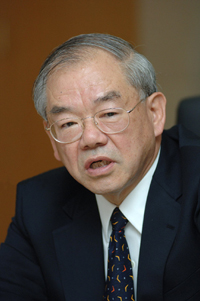 President Suh to Receive Honorary Doctorate from Romanian University
KAIST President Nam-Pyo Suh will receive an honorary doctorate degree from Babes-Bolyai University in Cluj-Napoca, Romania, in a ceremony at the university on April 3, school authorities said.
Andrei Marga, rector of the largest Romanian university, said in a letter to President Suh that the university decided to award Suh the title of Doctor Honoris Cause of Babes-Bolyai University, the highest academic honor of the university, in recognition of his "prestigious actions as academic leader of a university known worldwide and for contribution to cooperation between Romania and South Korea."
The university"s honorary doctorate is awarded to persons with illustrious achievements in the fields of science, technology, art, philosophy, and theology. Recent winners of the honor include Pope Benedict XVI; Cardinal Walter Kasper, President of the Pontifical Council for Promoting Christian Unity in Rome; Nobel Prize winners Rich Ernest of Switzerland and George Palade of the United States; philosophers Paul Ricoeur of France and Richard Rorty of the United States, among others.
The Babes-Bolyai University located in Cluj-Napoca with about 50,000 students offers education in three different languages, Romanian, Hungarian and German. It has the longest academic history in Romania, founded as a Jesuit college in 1581.
2009.04.02 View 13328
President Suh to Receive Honorary Doctorate from Romanian University
KAIST President Nam-Pyo Suh will receive an honorary doctorate degree from Babes-Bolyai University in Cluj-Napoca, Romania, in a ceremony at the university on April 3, school authorities said.
Andrei Marga, rector of the largest Romanian university, said in a letter to President Suh that the university decided to award Suh the title of Doctor Honoris Cause of Babes-Bolyai University, the highest academic honor of the university, in recognition of his "prestigious actions as academic leader of a university known worldwide and for contribution to cooperation between Romania and South Korea."
The university"s honorary doctorate is awarded to persons with illustrious achievements in the fields of science, technology, art, philosophy, and theology. Recent winners of the honor include Pope Benedict XVI; Cardinal Walter Kasper, President of the Pontifical Council for Promoting Christian Unity in Rome; Nobel Prize winners Rich Ernest of Switzerland and George Palade of the United States; philosophers Paul Ricoeur of France and Richard Rorty of the United States, among others.
The Babes-Bolyai University located in Cluj-Napoca with about 50,000 students offers education in three different languages, Romanian, Hungarian and German. It has the longest academic history in Romania, founded as a Jesuit college in 1581.
2009.04.02 View 13328 -
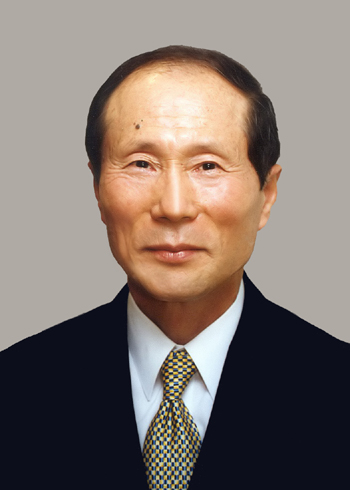 Respected Entrepreneur Chung Elected New Board Chairman of KAIST
Moon-Soul Chung, founder and former CEO of Mirae Corp. who is well known as the first-generation venture entrepreneur in Korea, was elected new chairman of the KAIST Board of Directors at the 193rd Regular Board Meeting held on March 20 in Seoul, school authorities announced Monday, March 23.
Born in 1938 in Imsil, North Jeolla Province, Chung graduated from the Oriental Philosophy Department of Won Kwang University. Chung founded Mirae Corp., a semiconductor equipment manufacturer, in 1983 and got his company listed on KOSDAQ and NASDAQ markets later. His business principles stressing transparency, integrity, and technology, earned the respect of Korean businesspeople.
In 2000, he suddenly announced retirement and handed over the presidency of his company to one of his managing directors. One year later, he donated 30 billion won to KAIST. It was by then the largest amount given by a single donor.
In 2007, he was awarded an honorary degree of doctor of engineering from KAIST. He formerly served as chairman of Venture Leaders Club, President CEO of Lycos Korea and chairman of the board of directors of Kookmin Bank.
2009.03.26 View 14907
Respected Entrepreneur Chung Elected New Board Chairman of KAIST
Moon-Soul Chung, founder and former CEO of Mirae Corp. who is well known as the first-generation venture entrepreneur in Korea, was elected new chairman of the KAIST Board of Directors at the 193rd Regular Board Meeting held on March 20 in Seoul, school authorities announced Monday, March 23.
Born in 1938 in Imsil, North Jeolla Province, Chung graduated from the Oriental Philosophy Department of Won Kwang University. Chung founded Mirae Corp., a semiconductor equipment manufacturer, in 1983 and got his company listed on KOSDAQ and NASDAQ markets later. His business principles stressing transparency, integrity, and technology, earned the respect of Korean businesspeople.
In 2000, he suddenly announced retirement and handed over the presidency of his company to one of his managing directors. One year later, he donated 30 billion won to KAIST. It was by then the largest amount given by a single donor.
In 2007, he was awarded an honorary degree of doctor of engineering from KAIST. He formerly served as chairman of Venture Leaders Club, President CEO of Lycos Korea and chairman of the board of directors of Kookmin Bank.
2009.03.26 View 14907